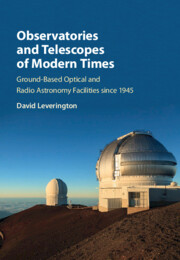 Observatories and Telescopes of Modern Times
Observatories and Telescopes of Modern Times from Part 1 - Optical Observatories
Published online by Cambridge University Press: 15 December 2016
The 200 inch (5.1 m) Hale Telescope
The early twentieth century had seen the emergence of the United States as the world leader in the construction of large optical telescopes. For example, two large solar telescopes had been built on Mount Wilson, California before the First World War. In addition, George W. Ritchey had also completed a 60 inch (1.5 m) reflector at the same observatory in 1908, and nine years later Ritchey and W. L. Kinney had completed the 100 inch (2.5 m) Hooker reflector there. As a result by the early 1920s Mount Wilson was also the premier observatory in the world.
No sooner had the 100 inch telescope been completed than George Ellery Hale, the director of the Mount Wilson Observatory, began to consider building an even larger instrument.(1) He mentioned his ideas to Francis Pease, who had recently joined the staff on Mount Wilson. By 1921 Pease, who by then had outlined the design for a 300 inch (7.5 m), was convinced that a 100 ft (30 m) telescope was feasible. But Hale was much more cautious, partly because of the difficulties that he had already experienced with building the 100 inch, and partly because of the difficulty he anticipated of raising the money to build such an enormous telescope. In fact, as he recognised, the time was not ripe for raising finances for even a 300 inch.
Nevertheless, Pease continued with designing his 300 inch. Then in 1926 he and Walter Adams took H. J. Thorkelson of the General Education Board of the Rockefeller Foundation on a tour of the Mount Wilson Observatory. During the tour, Pease showed him his design of the 300 inch. This design impressed Thorkelson so much that he mentioned it to Wickliffe Rose of the Rockefeller Foundation's International Education Board shortly afterwards.
Two years later Hale wrote an article for Harper's Magazine on ‘The Possibilities of Large Telescopes’ in which he outlined their importance. He also floated the idea of finding a donor to back the financing of a new large telescope, following on the path already trodden by Messrs Lick, Yerkes, Hooker and Carnegie in funding telescopes.
To save this book to your Kindle, first ensure [email protected] is added to your Approved Personal Document E-mail List under your Personal Document Settings on the Manage Your Content and Devices page of your Amazon account. Then enter the ‘name’ part of your Kindle email address below. Find out more about saving to your Kindle.
Note you can select to save to either the @free.kindle.com or @kindle.com variations. ‘@free.kindle.com’ emails are free but can only be saved to your device when it is connected to wi-fi. ‘@kindle.com’ emails can be delivered even when you are not connected to wi-fi, but note that service fees apply.
Find out more about the Kindle Personal Document Service.
To save content items to your account, please confirm that you agree to abide by our usage policies. If this is the first time you use this feature, you will be asked to authorise Cambridge Core to connect with your account. Find out more about saving content to Dropbox.
To save content items to your account, please confirm that you agree to abide by our usage policies. If this is the first time you use this feature, you will be asked to authorise Cambridge Core to connect with your account. Find out more about saving content to Google Drive.